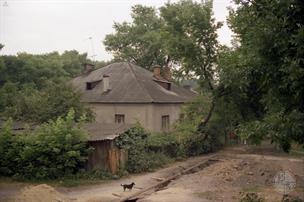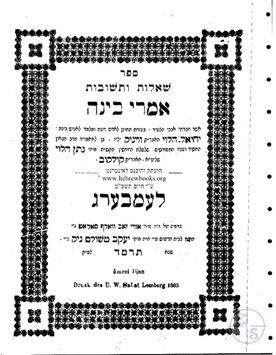Kulykiv
Lviv district, Lviv region
Sources:
- Jewish Cemeteries Initiative. Kulykiv Jewish Cemetery
- Wikipedia. קוליקיב
- Russian Jewish encyclopedia
Photo:
- Boris Khaimovich, Center for Jewish art. Synagogue in Kulykiv, Ukraine
- Hebrew Books. Imrei Binah
- Jewish Cemeteries Initiative. Kulykiv Jewish Cemetery
- Wikipedia. קוליקיב
- Russian Jewish encyclopedia
Photo:
- Boris Khaimovich, Center for Jewish art. Synagogue in Kulykiv, Ukraine
- Hebrew Books. Imrei Binah
Kulikiv was granted city rights in 1431, and until then it was called Busch. From the second half of the 17th century, the settlement was owned by the family of King Jan Sobieski, and then it was owned by the Radzibil family .
In the 17th and 18th centuries, the settlement became known for its weaving industry. After the First World War, the town was included in the scope of the Second Polish Republic . At the beginning of the 20th century, the town became known for the special bread baked there, which was marketed in Lviv.
The Jews settled in Kulykiv in the mid-16th century.
In 1765, 268 Jews lived in Kulykiv,
in 1880 - 1124 (34.8%),
in 1906 - 1211 (33.0%),
in 1910 - 1067 (27.2%),
in 1921 - 509 (17.6 %),
in 1931 - 602 Jews.
The Council of Four Lands carried out meetings in the town a few times during the 17th and 18th century.
The Jewish community was subordinated to the Lviv Kehila until the 17th century. By this time, a synagogue and a cemetery were established.
Famous rabbis served in this community, among them Rabbi Natan Halevi Rosenfeld, author of the book series 'Amri Bina' (named after his wife).
At the beginning of the 19th century, Rabbi Shlomo Kluger (1785–1869), aka Solomon ben Judah Aaron Kluger, was an Av Beit -Din of Brody, and simultaneously he fulfilled the duties of a rabbi in Kulykiv, Rava-Ruska and Lublin.
In 1892–1916, Kulykiv’s rabbi was Arye Laib Shtikler, from 1916 - Nosn Rosenfeld, son of Rabbi Nathan Halevi.
In the 17th and 18th centuries, the settlement became known for its weaving industry. After the First World War, the town was included in the scope of the Second Polish Republic . At the beginning of the 20th century, the town became known for the special bread baked there, which was marketed in Lviv.
The Jews settled in Kulykiv in the mid-16th century.
In 1765, 268 Jews lived in Kulykiv,
in 1880 - 1124 (34.8%),
in 1906 - 1211 (33.0%),
in 1910 - 1067 (27.2%),
in 1921 - 509 (17.6 %),
in 1931 - 602 Jews.
The Council of Four Lands carried out meetings in the town a few times during the 17th and 18th century.
The Jewish community was subordinated to the Lviv Kehila until the 17th century. By this time, a synagogue and a cemetery were established.
Famous rabbis served in this community, among them Rabbi Natan Halevi Rosenfeld, author of the book series 'Amri Bina' (named after his wife).
At the beginning of the 19th century, Rabbi Shlomo Kluger (1785–1869), aka Solomon ben Judah Aaron Kluger, was an Av Beit -Din of Brody, and simultaneously he fulfilled the duties of a rabbi in Kulykiv, Rava-Ruska and Lublin.
In 1892–1916, Kulykiv’s rabbi was Arye Laib Shtikler, from 1916 - Nosn Rosenfeld, son of Rabbi Nathan Halevi.
A famous Yiddish joke was common about the Jews debating the importance of their community or their leader, and the expression for a trifling subject was: "Er Claret tsi Kulikaver bagel, zijn Grosser von di Lemberger" (He checks if Kulikov's bagel looks bigger than Lemberg-Lvov 's ) . The phrase is also disparaging, especially considering that the merchants of Kulikov's special bread, most of whom were Jews.
During the 19th century, the Jewish population in the town grew, and it reached 1,211 people at the beginning of the 20th century.
After the First World War, many Jews left the town. Between the world wars, there were about 600 Jews in the town, close to a quarter of its residents, and Zionist activity took place there. This activity was banned with the occupation of the area by the Soviets in September 1939.
By 1921, the Jewish population dropped to 509 (17.6% of the total population).
In late June 1941, the Wehrmacht troops occupied Kulikov.
On July 1, 1941, the Ukrainian police staged a pogrom.
In September 1941, two labour camps were established in the surrounding villages.
On November 25, 1942, 586 Jews were deported to the Belzec death camp, and the remnants were expelled to the Zhovkva ghetto.
During the 19th century, the Jewish population in the town grew, and it reached 1,211 people at the beginning of the 20th century.
After the First World War, many Jews left the town. Between the world wars, there were about 600 Jews in the town, close to a quarter of its residents, and Zionist activity took place there. This activity was banned with the occupation of the area by the Soviets in September 1939.
By 1921, the Jewish population dropped to 509 (17.6% of the total population).
In late June 1941, the Wehrmacht troops occupied Kulikov.
On July 1, 1941, the Ukrainian police staged a pogrom.
In September 1941, two labour camps were established in the surrounding villages.
On November 25, 1942, 586 Jews were deported to the Belzec death camp, and the remnants were expelled to the Zhovkva ghetto.

- Home
- Shtetls
- Vinnytsia region
- Volyn region
- Dnipro region
- Donetsk region
- Zhytomyr region
- Zakarpattia region
- Zaporizhzhia region
- Ivano-Frankivsk region
- Kyiv region
- Kropyvnytskyi region
- Luhansk region
- Lviv region
- Mykolayiv region
- Odessa region
- Poltava region
- Rivne region
- Sumy region
- Ternopil region
- Kharkiv region
- Kherson region
- Khmelnytskyi region
- Chernihiv region
- Chernivtsi region
- Cherkasy region
- Crimea
- Synagogues
- Cemeteries
- Objects & guides
- Old photos
- History
- Contact
Jewish towns of Ukraine
Jewish towns of Ukraine
My shtetl
My shtetl
Donate

